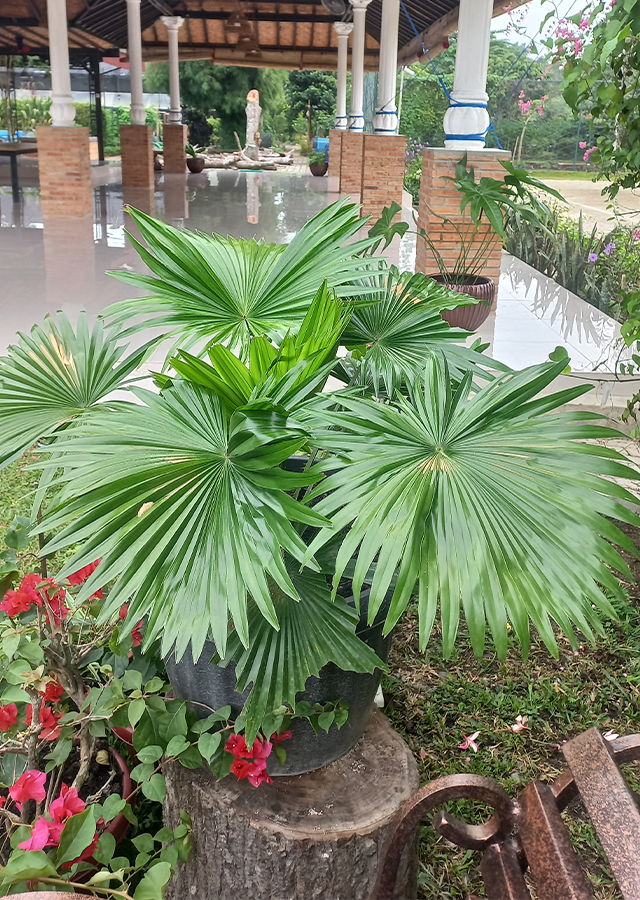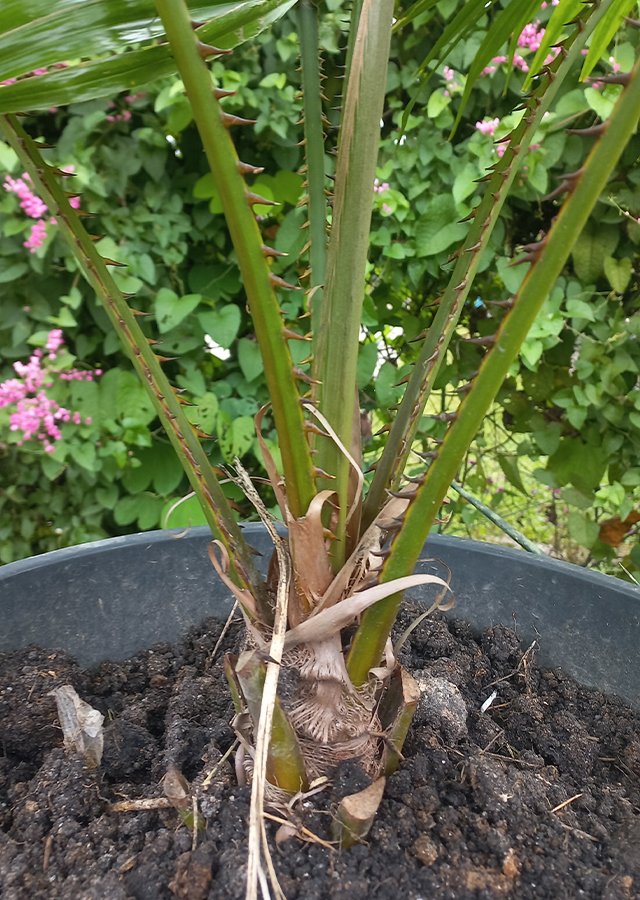Traditional Herbs from Saribus rotundifolius
fresh_wound
- Prepare enough fresh sadeng palm leaves, wash them thoroughly with running water.
- Crush until it becomes a paste.
- Apply the leaf paste on a fresh wound.
diarrhea
- Prepare enough fresh sadeng palm leaves, wash thoroughly with running water.
- Boil the leaves until boiling.
- Let it warm/cool.
- Strain then drink to treat diarrhea.
What is Saribus rotundifolius Looks like??



Parts of Saribus rotundifolius that could be used
- Leaf
Saribus rotundifolius Distribution
Sadeng palm is a native plant from Southeast Asia, namely the Philippines, Malaysia (Sabah), Indonesia (Kalimantan, Sulawesi, Maluku, Java). This species has now been widely cultivated as an ornamental plant throughout the world in tropical and subtropical countries. It is a very popular landscape plant, because it has attractively shaped leaves and ornamental fruit. These species are also often taken from the wild for local use as a source of food, medicinal plants, wood, and other material sources. Based on its function as a wood source and material resource, the leaves can be used for thatching house roofs, ship sails, food wrappers, fans, sun hats, and traditional Filipino raincoats. The stems can also be used as house poles, house floors, and the hardwood is used by Filipinos to make walking sticks. As a food source, the shoots are highly valued as a vegetable, however removal of the shoots can cause plant death, and the plant has been classified as 'Least Concern' on the IUCN Red List of Threatened Species (2009). Based on its function as a medicinal plant, the sadeng palm is also believed by the public to have good health properties which traditionally can overcome various disease complaints. One of them is that the people of Benguet in the Philippines have applied the leaves as a poultice to treat fresh wounds.Agroecology of Saribus rotundifolius
Sadeng palms can be found in abundance in swamp forests, seasonally dry swamp forests, mangrove fringes, rain forests, secondary forests, moist pine forests, along rivers, at altitudes up to 300 m above sea level. This species can only be cultivated in tropical and subtropical climates, as it does not tolerate temperatures close to zero, but for a very short time. The sadeng palm prefers a sunny location, but also does well in shade with some direct sunlight, but young specimens prefer partially shaded conditions. Its growth is very suitable in fertile clay soil, but can adapt to various types of well-drained soil, including clay, sand, with alkaline or acidic soil pH. This species also likes media that is evenly moist but not consistently wet. The sadeng palm is quite resistant to damage but is not tolerant of strong winds.
Morphology of Saribus rotundifolius
- Fibrous roots.
- Single, straight, smooth, slender stem about 20-25 cm in diameter, brown in color, bearing prominent leaf scars, and covered with beautiful grayish woven fibers above, below crown. Topped by a crown of 20 - 50 leaves.
- Palmate leaves (manjari compound leaves) are arranged spirally,\u00a0have leaf blades that are almost round like a fan, medium to large in size, shiny green, divided into many linear, stiff, notched lobes, leaves become more divided with age. Spiny stalk (at base of lower surface in young plants) supports leaf blade, long, and slightly curved.
- Flowers are small, yellow, bisexual. Long-stemmed inflorescence, about 0.9\u20131.2 m long, divided into 3 main axes containing up to 4 branched cream flower panicles.
- Fruit drupe, small, globose (round) to subglobose, about 11 - 25 mm in diameter with a very thin layer of flesh, the fruit is bright orange-red to red and turns black when ripe.
- Hard, round, brown seeds.
Cultivation of Saribus rotundifolius
- Plant propagation is done through seeds. If fresh seeds are kept warm, they can germinate easily within 2 months after sowing.
- Flower pollination is assisted by bees.
Saribus rotundifolius, more details :
Chemical Content of Saribus rotundifoliusSaponins, phlobatins, tannins, anthraquinones, cardiac glycosides, terpenes, alkaloids, flavonoids, deoxysugars, phenols.
Benefits of Saribus rotundifolius
Treats fresh wounds and diarrhea. Has activity as an antioxidant and antibacterial.
Simplisia of Saribus rotundifolius
Another Facts for Saribus rotundifolius :
Synonym of Saribus rotundifoliusCorypha rotundifolia Lam., Licuala rotundifolia (Lam.) Blume, Livistona microcarpa Becc.
Habitus of Saribus rotundifolius
Palm. Palm, annual, with solitary stem, grows to about 18 - 27 m in height
Habitat of Saribus rotundifolius
- Forest
- Roadside
- Land
No comments:
Post a Comment